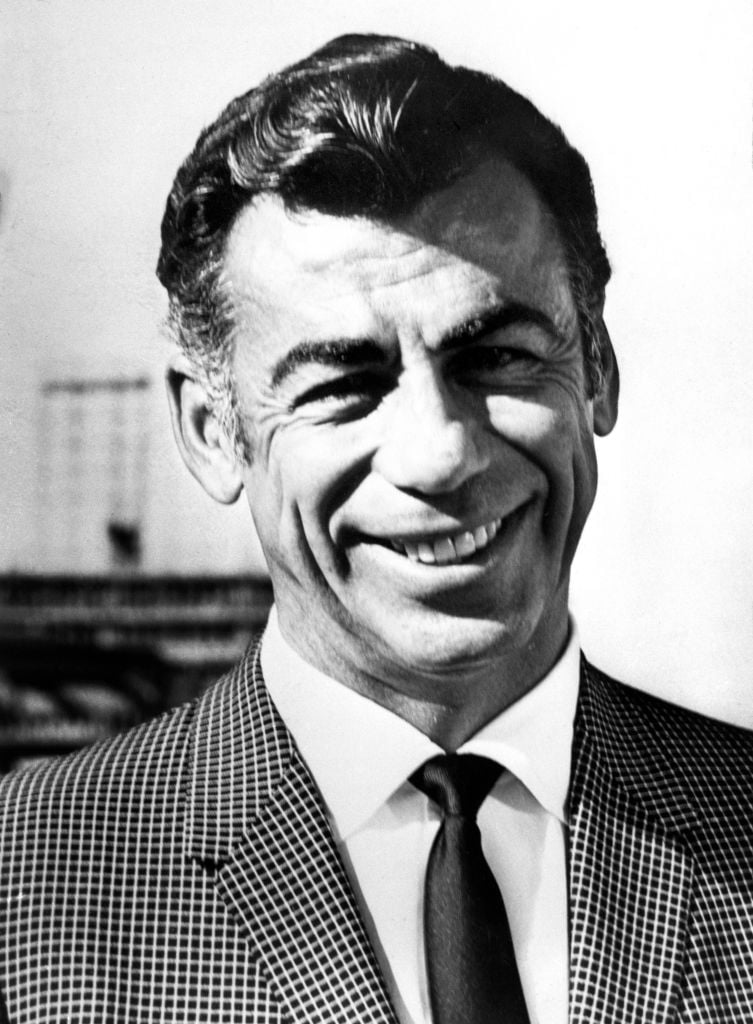A few months back, CelebrityNetWorth launched a newsletter called Deep Pockets. If you enjoy CNW’s articles, you MUST sign up for Deep Pockets. Every Saturday morning, we send one story to your inbox that details how a massive fortune was made… or lost. They get sent in order, so if you sign up today, you’ll start at #1.
Today, I decided to share a full Deep Pockets story as a CNW so you can see what it’s all about. As you’re about to see, Deep Pockets stories go much… deeper… than the average article you’ll find on the web. That’s intentional. As we enter a world where AI is making everything you read short, sloppy, and often totally inaccurate, Deep Pockets goes the other way – deeper, compelling, rich, gritty details that actually matter and make your head spin. The article below is about a tycoon named Kirk Kerkorian. If this seems like something you would enjoy reading every week, please sign up for Deep Pockets by entering your email in this form!
From Penniless Farm Boy… To King of Las Vegas
As the creator of CelebrityNetWorth, I get two questions all the time:
1) What celebrity is way richer than you’d guess?
Answer: Daisy Fuentes.
2) Who is your favorite billionaire?
Answer: Kirk Kerkorian.
Not Warren Buffett. Not Larry Ellison (though he is very cool). Not Mark Cuban.
Kirk Kerkorian.
Why do I love Kirk so much? He is the quintessential Deep Pockets icon. A dirt-poor kid from Fresno with an eighth-grade education who fought, flew, and gambled his way into the world’s biggest gambling empire. Best of all, he did it all under the radar. He was probably the most publicity-shy mogul of his era.
I bet most people reading this have never heard his name. And that’s pretty crazy because I bet most people reading this have stayed (and lost money) at one of his casinos.
Today I am going to tell you the incredible story of Kirk Kerkorian. And in doing so, hopefully, you’ll understand why I have long considered him my favorite billionaire.
Pop quiz: What do all of these casinos have in common?
- The MGM Grand
- The Mirage
- Treasure Island
- Bellagio
- Golden Nugget
- Boardwalk
- Monte Carlo
- Circus Circus
- Excalibur
- Luxor
- Mandalay Bay
- New York New York
- Aria
- Vdara
- Waldorf Astoria Las Vegas
Kirk Kerkorian owned all of them. Not at various points during his life, one or two at a time…
He owned ALL OF THEM.
Kirk owned a little more than half of all the rooms in Las Vegas. So, if you’ve gone to Vegas in the last 20 years, there’s a 50/50 chance you were giving money to Kirk Kerkorian.
Perhaps most impressively, Kirk built and managed this unbelievable empire completely under the radar. An empire that, just before the 2008 real estate crash, made him one of the 40 richest people in the world, with a net worth of $16 BILLION. And even at that peak, Kirk could have walked down Las Vegas Boulevard without getting noticed.
How did he pull it off?
A Titan Is Born
Kerkor Kerkorian was born on June 6, 1917, in Fresno, California. He was the youngest of four children born to Armenian immigrants who moved to America to escape what eventually became known as the Armenian Genocide, which saw around 1.5 million Christian Armenians murdered by the Ottoman Empire (today’s Turkey). The family did not speak English.
Kerkor’s father was a creative but unlucky entrepreneur. At one point, the family lived on a 120-acre farm just south of Bakersfield in an unincorporated town called Weedpatch, which even today appears to be just as bland as its name suggests. They operated a successful raisin farm during World War I.
Unfortunately, debts, bad bets and the 1920s recession plunged the family into poverty. They lost the farm to foreclosure and moved to Los Angeles.
When the family first arrived in Los Angeles, Kerkor didn’t speak a word of English. To fit in better, he changed his name to the more Americanized “Kirk.”
Things didn’t get better in Los Angeles. The family was evicted at least 20 times.
Kirk had to get a job to help the family get by. So, at the age of 9, he became a newsie.
When he was at school, Kirk was bullied for being poor, small, and having a weird accent. He was constantly getting into fights. His older brother, a trained semi-professional boxer, gave Kirk some lessons. These lessons eventually proved to be a bit too effective.
During one fight, Kirk nearly suffocated his opponent after landing a punch directly in his opponent’s throat, obliterating his Adam’s apple.
Worse, the bully was the son of a teacher, so even though he was defending himself, Kirk was kicked out and had to attend a nearby reform school. He was briefly enrolled in some vocational classes but dropped out for good after eighth grade.
His timing was not good. The early 1930s were the depths of the worst part of the Great Depression.
In 1933, when Kirk was 16, unemployment in the United States hit an all-time record high of 24.9%. For context, at the worst part of the Great Recession, October 2009, unemployment hit 10% in the US.
There was some good news on the horizon for the teenage Kirk Kerkorian. President Roosevelt’s New Deal created dozens of programs to get people back to work. One of those programs was called the Civilian Conservation Corps (CCC). The CCC put thousands of young men around the country to work planting trees, building parks, cutting trails in national parks, and fighting forest fires. CCC paid $30 per month and provided food, shelter, and clothing.
During his six-month CCC gig, Kirk cut trails around Mount Whitney. It was a fun but physically intense job that was performed during both extreme heat and extreme cold.
Upon returning to Los Angeles, Kirk got a job as a day laborer at the MGM studio lot, hauling boulders back and forth between sets under the scorching Hollywood sun.
Spoiler: In 36 years, Kirk would return to this very lot, not as a day laborer, but as the owner of MGM.
Rifle Right Kerkorian
Kirk continued to train as a boxer under his older brother, Nish Kerkorian. Fighting under the moniker “Rifle Right Kerkorian,” Kirk won 29 of his 33 amateur fights as a welterweight.
Decades later, as King of Las Vegas, he would remain a passionate fan and promoter of professional boxing.
Flying Lessons
Much like his future Las Vegas rival, Howard Hughes, Kirk fell in love with flying planes.
As the legend goes, one day in 1939, Kirk was working as a water heater installer when his customer, a veteran Navy pilot, offered to take him up in his plane on his lunch break.
Kirk said yes. He was instantly hooked on flying.
Kirk found a flight school that charged $3 an hour for lessons. Still short on funds, he negotiated a risky but creative way to score a discount. By declining to rent a parachute, the school knocked the fee down to $2.50 an hour 😅
Kirk’s next goal was to earn his commercial pilot’s license. Unfortunately, all the official flight academies had high fees AND required students to have a high school diploma.
Undeterred, Kirk found a school deep in the Mojave Desert that not only accepted him but offered to waive its training fee in exchange for mucking stalls and milking cows.
After six months of training (and shoveling shit and milking cows), Kirk earned his commercial pilot’s license.
World War II
Immediately after earning his commercial license, Kirk put his skills to use in the most perilous and profitable way possible: He signed on with Britain’s Air Force Ferry Command.
Why was the job so dangerous and profitable?
Kirk and a crew flew supplies 2,200 miles across the Atlantic Ocean from Canada to Scottland.
The plane’s base fuel range was… 1,400 miles.
Pilots could try to refuel along the way, but most – including Kirk – opted to roll the dice by coasting on tailwinds all the way to Scotland. In May 1944, he even set a speed record for the crossing by riding a high-altitude “Icelandic wave” tailwind.
Only 1 in 4 planes survived the journey. Hence the $1,000 per flight fee. Which, by the way, is the same as around $18,000 today after adjusting for inflation.
Kirk defied the odds, completing 33 transatlantic missions, earning $33,000, roughly $600,000 in today’s dollars.
His Own Private Airline
After the war, Kirk used his hard-earned savings to launch an airline. Specifically a charter airline. To get his business off the ground (literally), he used $5,000 of his savings to purchase one single-engine Cessna.
Often, his passengers were Los Angeles-based high-rollers hopping over to the newly booming desert gambling town… Las Vegas.
One of his periodic customers was the legendary gangster Bugsy Siegel, who was the owner of The Flamingo Hotel.
One of Bugsy’s flights to Las Vegas with Kirk took place on the night of June 18, 1947. Bugsy spent 30 minutes on the ground for a mysterious but clearly important face-to-face meeting. Then they flew back to LA. 48 hours later, Bugsy was gunned down while reading the newspaper at a mansion in Beverly Hills. The generally accepted theory is that Bugsy was murdered by his mob partners in The Flamingo, who were enraged by the hotel’s escalating costs and his skimming of the profits.
Unlike Bugsy, Kirk’s fortunes were just about to take off. Once again, literally. In 1947, Kirk used a mostly borrowed $60,000 to purchase a charter airline called Trans International Airlines (TIA).
As Las Vegas flourished throughout the 1950s, so did TIA. By 1960, TIA was generating more than $300,000 per year in revenue, primarily flying gamblers and cargo back and forth between Las Vegas and Los Angeles/San Francisco.
His First Jackpot
In the 1960s, demand for charter flights skyrocketed, especially for military contracts during the Vietnam War. TIA became one of the biggest charter operators serving the U.S. military, transporting troops and cargo overseas.
TIA went from shuttling gamblers on a single Douglas DC-3 to owning a fleet of jets that served civilian and military customers.
Kirk took TIA public in 1965. He used the capital raised to buy more jets and expand routes.
In 1968, Kirk sold TIA to Transamerica Corporation for $100 million in stock.
Kirk Kerkorian is shown in front of his International Hotel in Las Vegas. (Getty)
Viva Las Vegas
Kirk actually made his first Las Vegas investment in 1962. Using his profits from TIA, Kirk bought 80 acres of undeveloped land on the Las Vegas strip directly across the street from The Flamingo for $960,000. That’s the same as around $8.8 million in today’s dollars.
Before he could think about building his own casino, Kirk was then approached by a Georgia-based hotel developer named Jay Sarno. Sarno wanted to build the largest hotel in the world in Las Vegas. A palace. Specifically, Caesars Palace. And Jay wanted to build his palace on the land that Kirk owned.
A deal was struck. Jay would build the hotel on Kirk’s land in exchange for $15,000 per month in rent AND 15% of the casino’s profits.
Caesars Palace opened on August 5, 1966. Two years later, Kirk sold his land to Sarno for $9 million, roughly $80 million in today’s dollars.
As Caesars was becoming a huge success, Kirk was placing side bets. In 1967, he quietly paid $5 million for another 80-acre parcel on the Strip.
In 1969, a 30-story, 1,512-room colossus opened as the largest casino in the world. Kirk called it The International Hotel.
For opening night, Barbara Streisand performed.
The next marquee performer… on the marquee… was…
Elvis.
After Barbara, Elvis performed a sold-out 30-day residency that drew more than 4,000 guests per show. Elvis’ residency was so popular that Kirk struck a deal with Elvis’ manager, Colonel Tom Parker, that contracted Elvis to return every year for a fee of $5 million. Between 1969 and 1976, Elvis performed 636 sold-out shows at The International. A record that still stands today.
Meanwhile, perhaps because of the booming success of Caesars across the street, The Flamingo Hotel began to struggle. So, Kirk bought it.
Unfortunately, hot streaks always come to an end. At the peak of the late 1960s with Elvis packing seats and selling out rooms, Kirk’s shares in his Las Vegas holding company, International Leisure Corporation, were worth $180 million. A series of setbacks, including a sagging economy and (false) rumblings that Kirk was associated with mobsters, put him in a very over-leveraged position.
In early 1970, Kirk was forced to sell both The Flamingo and The International to Hilton for $16.5 million.
Kirk Kerkorian was down. But not out.
MGM
As all this was going on, Kirk was quietly (at first) acquiring shares in the publicly traded film studio Metro Goldwyn Mayer, better known as MGM. By the end of 1969, he owned 40% of the company’s stock. He soon controlled the board and more than 50% of the stock.
Thanks to a series of box office duds in recent years, MGM had been hemorrhaging money. Not prone to Hollywood sentimentality, Kirk, very controversially, proceeded to auction off most of the studio’s iconic props and Los Angeles real estate.
Everything had to go. And I do mean everything.
Chariots from “Ben-Hur”? They were Ben-Hurried out the door to the highest bidder.
Costumes from “Gone with the Wind”? Going, going, gone with the wind.
Dorothy’s ruby-red slippers? Arguably the MOST famous and iconic prop in Hollywood history? MGM tapped its toes three times and accepted $15,000. In December 2024, these same slippers were acquired at auction for $28 million.
You can see the full auction in the video below; the Ruby Slippers sell at around 4:30:
MGM Grand (The Original)
Kirk may not have been sentimental about MGM’s props, but he LOVED its extremely valuable library of films.
He also had a new idea in mind: Why not combine MGM’s old Hollywood glitz and glamour with a Las Vegas casino?
In 1973, Kirk opened the MGM Grand Hotel and Casino at the corner of Las Vegas and Flamingo Boulevards.
It was the largest hotel in the world at that time, with 2,100 rooms, a movie theater, an enormous casino floor, and a small theme park. Its floor area exceeded that of the Empire State Building.
The MGM Grand was a MASSIVE success right out of the gate. Money poured into MGM and Kirk’s pockets.
The party roared on under an enormous MGM “Leo the Lion” statue for the next seven years.
Unfortunately, tragedy struck on November 21, 1980, when a horrific fire swept through the MGM Grand. 85 people were killed. It remains the third-worst hotel fire in modern US history.
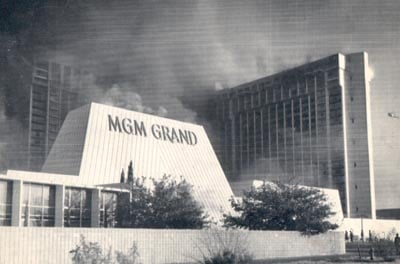
Wikimedia CC – Public Domain
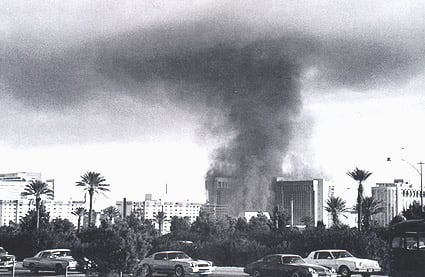
Wikimedia CC – Public Domain
In the aftermath, Kirk refused to wait for insurance companies to haggle with the victims. He went straight to the victims and negotiated a generous settlement that paid way more than they would have gotten from insurance. He used $50 million of his own money.
Remarkably, the MGM Grand reopened just eight months later.
In 1986, Kirk sold the MGM Grand to a slot machine company called Bally Manufacturing for $594 million ($1.7 billion in today’s dollars). Today, the hotel is called Bally’s.
In 1986, Kirk also sold MGM the studio. He sold MGM to Ted Turner for $1.5 billion. But that wasn’t the end of the story.
As soon as the deal was closed, Turner was drowning in a sea of debt that he could not control. Desperate, he sold everything but MGM’s film library back to Kirk for $300 million. In other words, Kirk sold the MGM film library for $1.2 billion. Ted Turner would go on to use the MGM library to launch Turner Classic Movies.
MGM Grand (The Sequel)
Unhappy that he did not own a major hotel/casino in Las Vegas, Kirk started dreaming again. In his dream, he didn’t envision just any hotel. His dream was to build a sprawling mega-resort that would totally revolutionize Sin City.
After spending an unprecedented $1 billion on construction costs, in 1993, Kirk opened the new MGM Grand, a 5,000-room palace that was the largest hotel in the world.
The complex featured 170,000 square feet of casino floor space, a 33-acre theme park, and a 15,000-seat arena for live events. Once again, MGM’s famous “Leo” the Lion greeted customers on Las Vegas Boulevard.
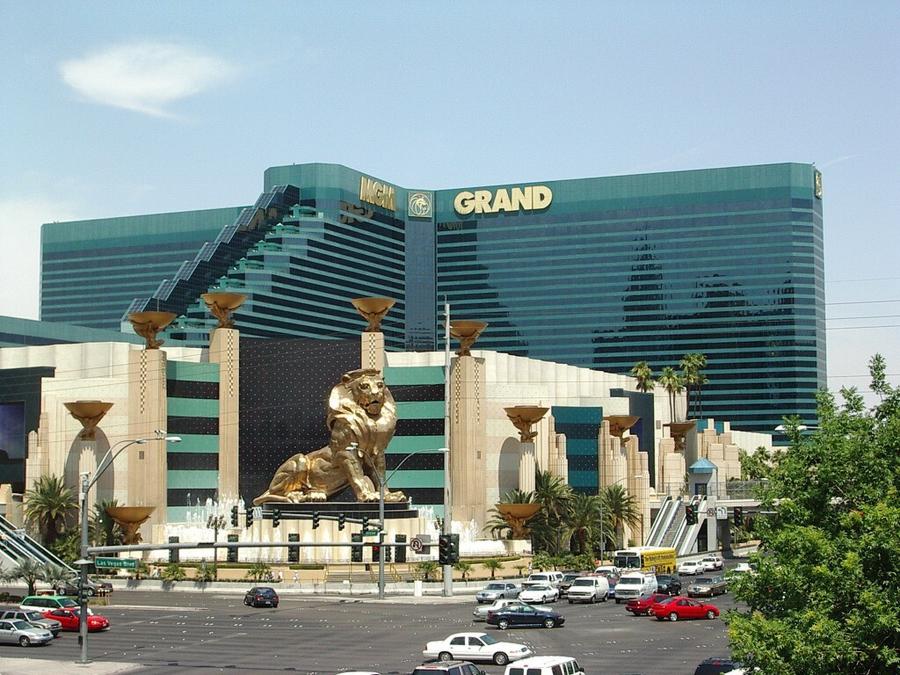
Photo by Mikano via Wikimedia Creative Commons
With his stunning new arena, the former “Rifle Right Kerkorian” set out to reinvent the professional boxing spectacle. He wanted MGM Grand’s boxing matches to be global events. He wanted fans in the nosebleeds and viewers at home to feel the electricity of the night in their bones.
And there was only one man on the planet who could deliver that kind of raw, electric energy:
There was just one problem: Mike was in prison.
On March 25, 1995, Mike Tyson was released from prison after serving 3 of a 6 year sentence.
That same month, Kirk personally orchestrated a deal that gave MGM Grand the exclusive right to host six Mike Tyson fights. The deal was worth $25 million per fight, $150 million in total.
Anyone who was alive in the 1990s remembers how electric and exciting Tyson’s MGM fights were. For better or worse, they were notorious global events.
- Tupac and his entourage attended Tyson’s third MGM fight on September 7, 1996. After Mike destroyed Bruce Seldon in a first-round TKO, Tupac and his entourage poured out onto the casino floor, where they encountered and beat up a rival. Later that evening, Tupac was shot six times. He died six days later.
- Tyson’s fourth fight was against Evander Holyfield. He actually lost in a controversial 11th-round TKO. It was controversial because Tyson’s team felt that Holyfield was getting away with head-butting Tyson.
- Tyson’s fifth fight was a rematch against Holyfield. Once again, Evander head-butted Tyson in an early round. Infuriated, Mike bit off a chunk of Evander’s ear 👂in the third round, leading to a disqualification.
Despite, or because of, these controversies, in the 1990s and early 2000s, the MGM Grand was the most exciting and important hotel in the world.
The King of Las Vegas
In 2000, Kirk/MGM acquired Steve Wynn’s Mirage Resorts for $4.4 billion. That gave Kirk ownership of:
- Mirage
- Bellagio
- Treasure Island
In 2005, Kirk/MGM acquired Mandalay Resorts for $7.9 billion. That gave Kirk ownership of:
- Mandalay Bay
- Luxor
- Excalibur
When this deal closed, Kirk owned 24 hotel/casino properties in Nevada, Michigan, and Mississippi, with 70,000 employees and $7 billion in annual revenue. He owned a little more than half of all the hotel rooms in Las Vegas.
In 2009, he completed construction on CityCenter, his boldest ever project – A $9 billion, 76-acre complex that still stands as the most expensive privately funded construction project in U.S. history. Today, CityCenter features:
- Aria
- Vdara
- Waldorf Astoria Las Vegas
- The Shops at Crystals
- Veer Towers condominiums
Today, MGM Resorts operates 31 properties around the world, including international destinations such as Macau. It generates around $17 billion in revenue per year.
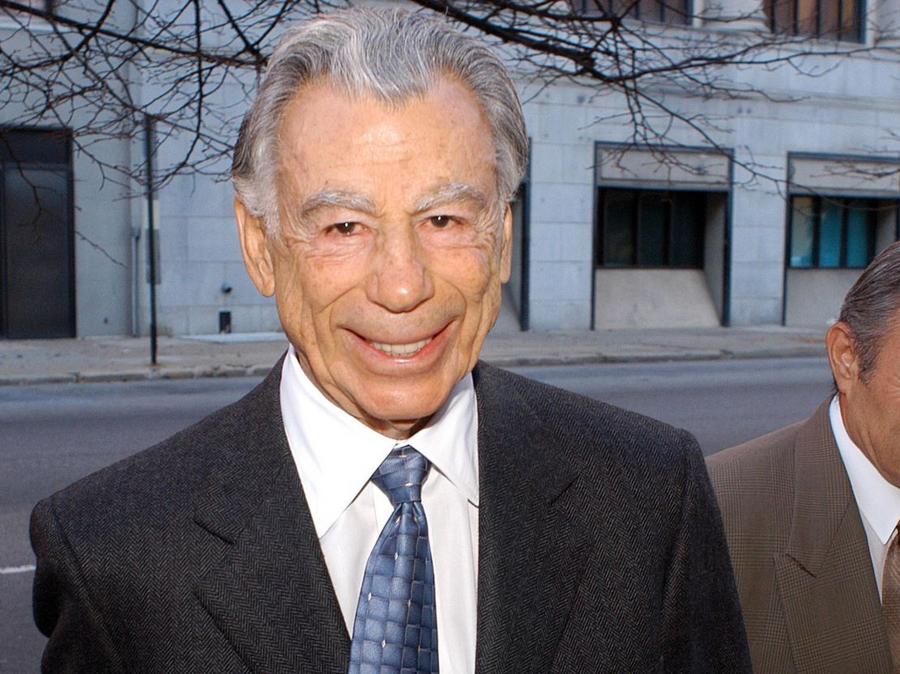
William Thomas Cain/Getty Images
Philanthropist
Later in life, Kerkorian became as notable for his generosity as for his business feats.
Though intensely private and media-shy, he quietly gave away hundreds of millions.
Moved by a devastating 1988 earthquake in Armenia, Kerkorian established the Lincy Foundation (once again, a portmanteau of his daughters’s names… Linda and Tracy).
Through Lincy, he funneled approximately $1 billion to rebuild schools, hospitals, and infrastructure in Armenia.
This immense act made him a national hero in Armenia – he was granted honorary citizenship and the title of National Hero of Armenia for his contributions. They even put him on a stamp:
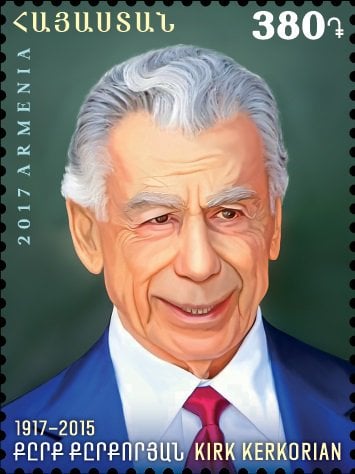
(wikimedia creative commons public domain)
Lincy also donated tens of millions to charities in Nevada and Los Angeles, including funding medical research and education.
By 2000, Time magazine listed him among the top ten American philanthropists. True to form, Kerkorian sought no fanfare for his giving.
In April 2021 (several years after his death), the University of Nevada Las Vegas named its then-under-construction 135,000-square-foot medical building the Kirk Kerkorian School of Medicine. Speaking of things being named in Kirk’s honor…
Tennis Partners
For most of his life, Kirk Kerkorian kept a strict routine: He worked until 4 pm then did one hour of vigorous exercise. His favorite form of vigorous exercise was tennis. He played throughout his life. In fact, in his 80s, he was the #3 ranked 80+ tennis player in America.
This daily routine is probably why Kirk lived to be 98 and was in generally good health right up to the end. We should all take note.
One of Kirk’s longtime closest personal friends was his tennis coach, Mike.
One day in 1963, Kirk was eating lunch at one of his hotels when he noticed his waiter had a familiar accent. Kirk was stunned to learn that his waiter was Armenian. They were likely the only two Armenians in all of Las Vegas, perhaps all of Nevada. And Mike happened to work at a restaurant in Kirk’s hotel!
He also knew that “Mike” could not possibly have been his real name. Sure enough, just like Kirk had done decades earlier, Mike Americanized his name to fit in better. Mike’s real name was Emanoul Aghassian.
As if this wasn’t enough, Kirk then learned that Mike coached tennis and was a former boxer. Mike actually represented Iran as a boxer at the 1948 and 1952 Summer Olympics.
They were practically twins separated at birth.
When Mike moved to Las Vegas in 1963, after initially immigrating to Chicago, he had a wife and two kids.
In 1967, Mike and his wife Elizabeth welcomed a third child.
On April 29, 1970, Mike and Elizabeth welcomed their fourth child, a boy. In honor of his friend, this baby boy was given the middle name “Kirk.”
This boy was born with a tennis racquet in his hand. Mike was intense and relentless with the goal of making him a star player. By the age of 7, he was hitting 2,500 balls a day after school. At 13, he was shipped off to a tennis academy.
For better or worse, this regimen paid off.
In April 1995, Andre Kirk Agassi became the #1 tennis player in the world.
Mike and Kirk remained best friends for the rest of their respective lives. And Kirk became a regular and generous supporter of Andre’s future philanthropic endeavors. For example, at the 2011 Andre Agassi Foundation for Education Grand Slam for Children, Kirk chipped in a cool $18 million. That night, the foundation raised $26 million, which went to support the Andre Agassi Preparatory Academy in Las Vegas. At the end of the night, Andre addressed his namesake:
“Mr. Kerkorian, I respect you, I love you. On behalf of this foundation, on behalf of every child who will walk the halls of Agassi Prep, and on behalf of the millions and millions of people he has helped and continues to help who he will never meet, thank you.”
Death and a Weird Personal Life
Kirk Kerkorian died on June 15, 2015, at the age of 98. The majority of his $4 billion estate went to charity.
Kirk was married four times during his life. His two daughters, Tracy and Linda, came from his second marriage, which lasted from 1954 to 1984.
In the 1990s, Kirk began dating a former tennis pro named Lisa Bonder, who was 48 years his junior. Kirk and Lisa had what we would today call a “situationship.”
They would break up, then make up. He would kick her out of his mansion, then a week later invite her on his yacht for a month in the Mediterranean.
They were married for 30 days in 1999. Honestly, the whole saga is too much to get into here. What I will say is that at one point, Lisa had a daughter and she claimed Kirk was the father. In 2002, she was awarded $320,000 per month in child support, the largest in California history.
Unfortunately, Kirk was not the father. It would take several years to prove, but the girl’s actual father was film producer Steve Bing (who also strangely had a disputed child with Elizabeth Hurley, who proved to be his).
Paternity was proven after a private investigator hired by Kirk’s lawyer took some dental floss from Bing’s trash.
Kirk was devastated. Even with some lingering doubts, he had raised that child as his own up to that point. Ever the class act, even after finding out he was not the child’s father, Kirk set up a multi-million-dollar trust fund for her benefit.
In another bizarre twist, both the private investigator and Kirk’s lawyer were eventually convicted and sent to prison for illegal wiretapping.
Around 2012, Kirk was engaged to Rodney Dangerfield’s widow, Joan Dangerfield.
For his 95th birthday, on June 6, 2012, Joan arranged for an elaborate flash mob to surprise Kirk at the Beverly Hills Hotel. Kirk was basically allergic to attention, so you can imagine his extreme discomfort when he was walking through the hotel grounds and was suddenly interrupted by a very public and loud birthday flash mob.
Actually, you don’t have to imagine. The whole flash mob event was filmed and posted on YouTube:
Kirk married a fourth time in 2014 to a woman named Una Davis, once again a former tennis player. They were married for 57 days. Their divorce proceedings were underway when Kirk died in June 2015. Three years later, she was awarded $12.5 million AND $60 million that would go to two foundations that she would advise.
My Favorite Billionaire
Hopefully, you now understand why Kirk Kerkorian is my favorite billionaire. Or, at the very least, you have a newfound respect for him! He was a dirt-poor farm boy who fought, flew, and gambled his way to owning Las Vegas, a film studio, and so much more. He built his empire without attracting any attention or flash and remained a class act for his entire life.
Finally. If you enjoyed this story, please sign up for Deep Pockets! On the next edition of Deep Pockets, I’m writing about a different Armenian-American billionaire whose initials are “K.K.” But unlike Kirk, this billionaire has never met a camera SHE didn’t like. Any guesses?
Content shared from www.celebritynetworth.com.

